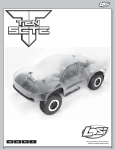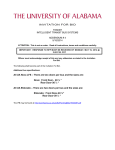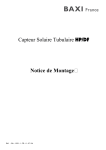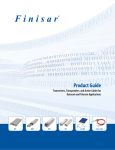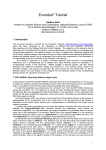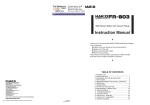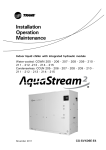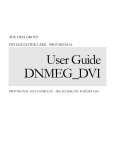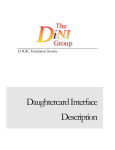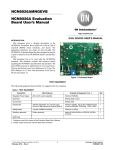Download User Manual
Transcript
THE DINI GROUP LOGIC Emulation Source User Manual DNMEG_INTERCON LOGIC EMULATION SOURCE DNMEG_INTERCON User Manual Version 1.0 © The Dini Group 7469 Draper Ave. La Jolla, CA92037 Phone 858.454.3419 • Fax 858.454.1278 [email protected] www.dinigroup.com Copyright Notice and Proprietary Information Copyright © 2007 The Dini Group. All rights reserved. No part of this copyrighted work may be reproduced, modified or distributed in any form or by any means, without the prior written permission of The Dini Group. Right to Copy Documentation The Dini Group permits licensee to make copies of the documentation for its internal use only. Each copy shall include all copyrights, trademarks, disclaimers and proprietary rights notices. Disclaimer The Dini Group has made reasonable efforts to ensure that the information in this document is accurate and complete. However, The Dini Group assumes no liability for errors, or for any incidental, consequential, indirect, or special damages, including, without limitation, loss of use, loss or alteration of data, delays, or lost profits or savings, arising from the use of this document or the product which it accompanies. Table of Contents INTRODUCTION ..................................................................................................................................................................................................................... 1 1 2 3 4 5 ABOUT THE DNMEG_INTERCON DAUGHTER CARD .................................................................................................................................. 1 DNMEG_INTERCON DAUGHTER CARD FEATURES .................................................................................................................................... 1 PACKAGE CONTENTS: ..................................................................................................................................................................................... 2 INSPECT THE BOARD ....................................................................................................................................................................................... 2 ADDITIONAL INFORMATION ............................................................................................................................................................................ 2 HARDWARE DESCRIPTION ................................................................................................................................................................................................ 4 1 2 3 OVERVIEW ....................................................................................................................................................................................................... 4 EXTERNAL CLOCK INPUT ................................................................................................................................................................................ 5 LED INDICATORS ............................................................................................................................................................................................ 6 3.1 RESET LED’s .......................................................................................................................................................................................................... 6 3.2 Power Supply Status LED’s .................................................................................................................................................................................... 6 4 DAUGHTER CARD HEADERS ........................................................................................................................................................................... 6 4.1 Daughter Card clocking.......................................................................................................................................................................................... 7 4.2 Daughter Card Header Pin Assignments ............................................................................................................................................................... 7 Special Pins on the Daughter Card Header..................................................................................................................................................... 9 4.2.1 VREF .................................................................................................................................................................................................................................. 9 4.3 VCCO Power Supply .................................................................................................................................................................................................. 9 4.4 Daughter Card Header IO Connections ............................................................................................................................................................... 10 4.5 Power and Reset .................................................................................................................................................................................................... 18 4.6 Insertion/Removal of Daughter Card ................................................................................................................................................................... 18 4.7 MEG Array Specifications .................................................................................................................................................................................... 20 5 MECHANICAL ................................................................................................................................................................................................ 21 5.1 Dimensions ............................................................................................................................................................................................................ 21 List of Figures Figure 1 - DNMEG_INTERCON Daughter Card ............................................................................................................................................................................................. 1 Figure 2 - DNMEG_INTERCON Daughter Card Block Diagram ................................................................................................................................................................. 4 Figure 3 – External Clock Input .............................................................................................................................................................................................................................. 5 Figure 4 - Daughter Card Header Pin Assignments ............................................................................................................................................................................................. 8 Figure 5 - VCCO Adjustable Linear Power Supplies ......................................................................................................................................................................................... 10 Figure 6 - Daughter Card Header Power & RESET .......................................................................................................................................................................................... 18 List of Tables Table 1 – Connections between External Clock Input and MEG-Array Connector ..................................................................................................................................... 5 Table 2 - RESET LED's ........................................................................................................................................................................................................................................... 6 Table 3 – Power Supply Status LED’s .................................................................................................................................................................................................................... 6 Table 4 - Daughter Card Header IO Connections ............................................................................................................................................................................................. 10 Table 5 – Daughter Card Reset Signal (DC_RSTn) ........................................................................................................................................................................................... 18 1 Chapter I N T R O D U C T I O N Introduction This User Manual accompanies the DNMEG_INTERCON Daughter Card. 1 About the DNMEG_INTERCON Daughter Card The DNMEG_INTERCON Daughter Card allows the user to expand on the FPGAto-FPGA interconnect utilizing the daughter card IO as interconnect. The MEG-Array IO banks are connected 1:1, thus providing a bridging function between the headers. The DNMEG_INTERCON Daughter Card can be used on any of the Dini Group products that have two adjacent MEG-Array Daughter Card Headers, e.g. DN9000K10PCI, DN9000K10PCI. 2 DNMEG_INTERCON Daughter Card Features Figure 1 - DNMEG_INTERCON Daughter Card DNMEG_INTERCONN User Manual www.dinigroup.com 1 I N T R O D U C T I O N DNMEG_INTERCON Daughter Card features the following: • Daughter Card Headers (x3) LVDS – MEG-Array (400-pin) interface to DN900xK10xxx products • External Clock Input - LVDS (SMA x 2) • Power Supply Status LED’s (x6) • VCCO Linear Power Supplies (x3) 3 Package Contents: The DNMEG_INTERCON Daughter Card would normally accompany one of the The Dini Group Logic Emulations products, but could be ordered as a separate item. 4 Inspect the Board Place the board on an anti-static surface and inspect it to ensure that it has not been damaged during shipment. Verify that all components are on the board and appear intact. 5 Additional Information For additional information, please visit http://www.dinigroup.com/. The following table lists some of the resources you can access from this website. You can also directly access these resources using the provided URLs. Resource User Manual Description/URL This is the main source of technical information. The manual should contain most of the answers to your questions Demonstration Videos MEG-Array Daughter Card header insertion and removal video Dini Group Web Site The web page will contain the latest user manual, application notes, FAQ, articles, and any device errata and manual addenda. Please visit and bookmark: http://www.dinigroup.com E-Mail You may direct questions and feedback to the Dini Group DNMEG_INTERCONN User Manual www.dinigroup.com 2 I N T R O D U C T I O N Resource Description/URL using this e-mail address: [email protected] Phone Support Call us at 858.454.3419 during the hours of 8:00am to 5:00pm Pacific Time. FAQ The download section of the web page may contain a document called DNMEG_INTERCON Frequently Asked Questions (FAQ). This document is periodically updated with information that may not be in the Users Manual. DNMEG_INTERCONN User Manual www.dinigroup.com 3 H A R D W A R E 2 Chapter D E S C R I P T I O N Hardware Description This chapter describes the functional blocks of the design and focuses on the Hardware implementation. 1 Overview LED7 LED6 LED5 LED3 LED4 LED2 LED1 LED0 The DNMEG_INTERCON Daughter Card allows the user to expand on the FPGAto-FPGA interconnect utilizing the MEG-Array Daughter Card header IO banks as interconnect. A high level block diagram of the DNMEG_INTERCON Daughter Card is shown in Figure 2, followed by a brief description of each section. MEG ARRAY – Receptacle (400Pin) – Bottom (P2) 74390-101LF MEG ARRAY – Plug (400Pin) – Top (P3) 84520-102LF MEG ARRAY – Receptacle (400Pin) – Bottom (P1) 74390-101LF Figure 2 - DNMEG_INTERCON Daughter Card Block Diagram DNMEG_INTERCON User Manual www.dinigroup.com 4 The DNMEG_INTERCON Daughter Card provides two 400-pin MEG-Array connectors (P1, P2) on the bottom of the printed circuit board assembly (PCBA) and an additional 400-pin MEG-Array connector (P3) on the top of the PCBA. The MEGArray IO banks are connected 1:1, thus providing a bridging function between the headers. The 400-pin MEG-Array connectors on the bottom of the printed circuit board assembly (PCBA) are used to interface to the Dini Group products, e.g. DN9000K10PCI. The 400-pin MEG-Array connector on the top of the PCBA can be used for IO expansion utilizing the DNMEG_Obs Daughter Card. An external clocking (LVDS) option is provided via an SMA pair. Independent linear power supplies are used to drive the IO bank voltages. Discrete LED’s indicate reset status and power supply presence. 2 External Clock Input An external clocking (LVDS) option is provided via a 50Ω SMA pair (J1, J2), see Figure 3. Resistors (R4, R5) can be replaced by capacitors to allow for AC-coupling of the external clock input. For single ended solutions, resistors (R2, R6) can be used to terminate the signal. P1-1 C1 H1 B2 D2 G2 J2 GCAP GCAN P12V_1 P12V_2 P5V_1 P5V_2 P3.3V_1 P3.3V_2 P3.3V_3 1A PER PIN A1 K1 GCBP GCBN GCCP GCCN E1 F1 CLK_DC_B_0p CLK_DC_B_0n E3 F3 CLK_DC_B_1p CLK_DC_B_1n E5 F5 CLK_DC_EXT_2p CLK_DC_EXT_2n J1 R2 (DNI-49.9R) R4 0R R5 0R 2 3 142-0701-501 J2 R6 (DNI-49.9R) RSTn 5 1 4 Clock, Power, Reset 5 1 4 2 3 142-0701-501 74390-101LF Figure 3 – External Clock Input The connections between the SMA connectors and the MEG-Array connector are shown in Table 1. Table 1 – Connections between External Clock Input and MEG-Array Connector Signal Name SMA (Pin) MEG-Array (Pin) CLK_DC_EXT_2p J1.1 P1.E5 CLK_DC_EXT_2n J2.1 P1.F5 DNMEG_INTERCONN User Manual The Dini Group 5 3 LED Indicators The DNMEG_INTERCON provides various LED’s to indicate that status of the board. 3.1 RESET LED’s Two red LED’s are provided to indicate the status of the DC_B_RSTn and DC_T_RSTn reset signals. The LED’s can be turned ON by driving the corresponding pin LOW. Table 2 describes the user LED’s and their associated pin assignments on the MEG-Array connector. Table 2 - RESET LED's Signal Name MEG-Array (pin) LED DC_B_RSTn P1.J2 DS1 DC_T_RSTn P2.J2 DS2 3.2 Power Supply Status LED’s Five green LED’s are provided to indicate the presence of various power supplies. Table 3 describes the power supply status LED’s and their associated voltage source. Table 3 – Power Supply Status LED’s Signal Name Power Supply LED P12V P1.A1, P1.K1 DS3 P5V P1.C1, P1.H1 DS4 P1.B2, P1.D2, P1.G2 DS5 VCCO_DC_B0 U1.1 DS6 VCCO_DC_B1 U2.1 DS7 VCCO_DC_B2 U3.1 DS8 P3.3V 4 Daughter Card Headers The DNMEG_INTERCON Daughter Card provides two 400-pin MEG-Array connectors (P1, P2) on the bottom of the printed circuit board assembly (PCBA) and an additional 400-pin MEG-Array connector (P3) on the top of the PCBA. The MEGArray IO banks are connected 1:1, thus providing a bridging function between the headers. The 400-pin MEG-Array connectors on the bottom of the printed circuit board assembly (PCBA) are used to interface to the Dini Group products, e.g. DNMEG_INTERCONN User Manual The Dini Group 6 DN9000K10PCI. The 400-pin MEG-Array connector on the top of the PCBA can be used for IO expansion utilizing the DNMEG_Obs Daughter Card. All signals on the DNMEG_INTERCON Daughter Card Headers are all routed as differential, 50-Ohm transmission lines. No length-matching is done on the PCB for Daughter Card signals, (except within a differential pair) because the Virtex-5 FPGA is capable of variable-delay input using the built-in IDELAY capabilities. Other connections on the daughter card connector system include three dedicated, differential clock connections for inputting global clocks from an external source, power connections, bank VCCO power, and a reset signal. 4.1 Daughter Card clocking Refer to External Clock Input in this User Manual. 4.2 Daughter Card Header Pin Assignments The pin assignments of the DNMEG_INTERCON Daughter Card Headers were designed to reduce cross talk to manageable levels while operating at full speed of the Virtex-5 LVDS standards. The Daughter Card Header is divided into three banks. The ground-to-signal ratio of the connector is 1:1, refer to Figure 4. General purpose IO is arranged in a GSGS pattern to allow high speed single-ended or differential use. On the host, these signals are routed as loosely-coupled differential signals, meaning when used differentially, they benefit from the noise-resistant properties of a differential pair, but when used in a single-ended configuration, they do not interfere with each other excessively. DNMEG_INTERCONN User Manual The Dini Group 7 A B C D E F G H J K 1 2 3 4 5 6 +12V +5V +3.3V B0 L1P B0 L2P B0 L5P 7 8 B0 L9P 9 10 B0 L13P 11 12 B0 L17P 13 14 B0 L21P 15 16 B0 L25P 17 18 B1 L3P 19 20 21 22 23 24 25 26 27 28 29 30 31 32 B1 L7P B0 L10P B1 L4N B1 L7N B1 L8N B1 L11N B1 L15N B1 L19N B1 L23N B2 L1N 33 34 35 36 B2 L13P 37 38 39 40 B2 L17P B2 L5N B2 L9N B1 L31N B2 L25P B2 L25N B2 L26P B2 L26N B2 L27P B2 L27N B2 L28P B2 L28N B2 L13N B2 L22P B2 L22N B1 L10P 19 20 21 22 23 24 25 26 27 28 29 30 31 32 VCCO 1 B1 L26N B2 L4P B2 L4N B2 L8P B2 L8N B2 L11P VCCO 2 B2 L12P 33 34 B2 L16P 35 36 B2 L20P 37 38 39 40 B2 L12N B2 L15P B2 L15N B2 L16N B2 L19P B2 L19N B2 L20N B2 L23P B2 L23N 17 18 B1 L26P B2 L7P B2 L31N B1 L6P B1 L22P B2 L3P B2 L11N B2 L31P 15 16 B1 L22N B2 L7N B2 L18N B1 L2P B1 L18P B1 L25P B2 L30N 13 14 B1 L18N B2 L3N B2 L30P B0 L24P B1 L14N B1 L21P B2 L29N 11 12 B1 L14P B1 L17P B1 L25N B2 L14N B2 L17N B1 L13P B1 L21N B2 L29P B2 L18P B1 L10N B1 L17N B2 L10N B2 L14P B2 L21N B1 L31P B2 L6N B2 L10P B1 L9P B1 L13N B2 L2N B2 L6P B2 L21P B1 L30N B1 L24N B2 L2P B2 L5P B1 L30P B1 L20N B1 L24P B2 L1P B1 L29N B1 L16N B1 L20P B1 L23P B1 L29P B0 L20P B1 L6N B1 L9N B1 L12N B1 L16P B1 L5P B1 L28N 9 10 B1 L2N B1 L5N B1 L28P B1 L12P B1 L1P B1 L27N B0 L16P B0 L24N B1 L1N B1 L27P B1 L8P B0 L23P B0 L31N 7 8 B0 L20N B0 L23N B0 L31P B1 L4P B1 L19P B0 L30N B0 L26N B1 L3N B2 L9P B0 L30P B0 L26P B0 L19P 1 2 3 4 5 6 B0 L12P B0 L16N B0 L19N B0 L22N B0 L25N B0 L15P B0 L29N VCCO 0 B0 L12N B0 L15N B0 L29P B0 L22P B0 L21N B0 L11P B0 L28N B0 L18N B0 L8P B0 L8N B0 L11N B0 L28P B0 L18P B1 L15P B0 L27N B0 L14N B0 L17N B1 L11P B0 L7N B0 L27P B0 L4P B0 L4N B0 L7P GCCN B0 L10N B0 L14P RSTn B0 L3N GCCP +12V B0 L3P GCBN B0 L6N B0 L13N VCCO 2 GCBP B0 L6P B0 L9N VCCO 1 +3.3V B0 L2N B0 L5N +5V GCAN +3.3V B0 L1N VCCO 0 GCAP B2 L24P B2 L24N A B C D E F G H J K Figure 4 - Daughter Card Header Pin Assignments DNMEG_INTERCONN User Manual The Dini Group 8 4.2.1 Special Pins on the Daughter Card Header VREF These pins are connected 1:1 on the board and the function is determined be the mother board. GCAp/n, GCBp/n, and GCCp/n These pins are connected 1:1 on the board and the function is determined be the base board. 4.3 VCCO Power Supply On the Virtex-5 FPGA each IO bank has its own VCCO pins. VCCO is determined by the IO standard for that particular IO bank. Since a daughter card will not always be present on a daughter card connector, a VCCO bias generator is used on the motherboard for each daughter card bank to keep the VCCO pin on the FPGA within its recommended operating range. The Daughter Card drives VCCO to the required level for the particular IO standard. The VCCO impressed by the Daughter Card needs to satisfy the VIH(MAX) of the FPGA on the host board. There are three Adjustable Linear Power Supplies (U1, U1, and U2) on the DNMEG_INTERCON Daughter Card, refer to Figure 5. Refer to the datasheet for the LT1963A from Linear Technology on how to adjust the output voltages. DNMEG_INTERCONN User Manual The Dini Group 9 TP1 1 P3.3V GND U1 8 5 C3 10uF 16V 20% CERAMIC C4 0.1uF 3 6 7 IN OUT SHDN SENSE/ADJ GND GND GND NC VCCO_DC_B0 VCCO_DC_B0 1 2 R1 1.1K 4 R3 1K LT1963AES8/SO8 C5 10uF 16V 20% CERAMIC C6 0.1uF TP2 1 P3.3V GND U2 8 5 C9 10uF 16V 20% CERAMIC C10 0.1uF 3 6 7 IN OUT SHDN SENSE/ADJ GND GND GND NC VCCO_DC_B1 VCCO_DC_B1 1 2 R8 1.1K 4 R9 1K LT1963AES8/SO8 C11 10uF 16V 20% CERAMIC C12 0.1uF TP3 1 P3.3V GND U3 8 5 C15 10uF 16V 20% CERAMIC C16 0.1uF 3 6 7 IN OUT SHDN SENSE/ADJ GND GND GND NC VCCO_DC_B2 VCCO_DC_B2 1 2 R11 1.1K 4 R12 1K LT1963AES8/SO8 C17 10uF 16V 20% CERAMIC C18 0.1uF Figure 5 - VCCO Adjustable Linear Power Supplies 4.4 Daughter Card Header IO Connections Table 4 lists the interconnect between the Daughter Card Headers. Table 4 - Daughter Card Header IO Connections Signal Name MEG-Array (Pin) MEG-Array (Pin) MEG-Array (Pin) CLK_DC_B_0N P1-F1 P2-F1 P3-F1 CLK_DC_B_0P P1-E1 P2-E1 P3-E1 CLK_DC_B_1N P1-F3 P2-F3 P3-F3 CLK_DC_B_1P P1-E3 P2-E3 P3-E3 CLK_DC_B_2N P2-F5 P3-F5 CLK_DC_B_2P P2-E5 P3-E5 DNMEG_INTERCONN User Manual The Dini Group 10 Signal Name MEG-Array (Pin) CLK_DC_EXT_2N P1-F5 CLK_DC_EXT_2P P1-E5 DC_B_RSTN P1-J2 DC_T_RSTN MEG-Array (Pin) MEG-Array (Pin) P2-J2 P3-J2 DC_B0N1 P1-B4 P2-B4 P3-B4 DC_B0N10 P1-D8 P2-D8 P3-D8 DC_B0N11 P1-G8 P2-G8 P3-G8 DC_B0N12 P1-J8 P2-J8 P3-J8 DC_B0N13 P1-B10 P2-B10 P3-B10 DC_B0N14 P1-D10 P2-D10 P3-D10 DC_B0N15 P1-G10 P2-G10 P3-G10 DC_B0N16 P1-J10 P2-J10 P3-J10 DC_B0N17 P1-B12 P2-B12 P3-B12 DC_B0N18 P1-D12 P2-D12 P3-D12 DC_B0N19 P1-G12 P2-G12 P3-G12 DC_B0N2 P1-D4 P2-D4 P3-D4 DC_B0N20 P1-J12 P2-J12 P3-J12 DC_B0N21 P1-B14 P2-B14 P3-B14 DC_B0N22 P1-D14 P2-D14 P3-D14 DC_B0N23 P1-G14 P2-G14 P3-G14 DC_B0N24 P1-J14 P2-J14 P3-J14 DC_B0N25 P1-B16 P2-B16 P3-B16 DC_B0N26 P1-D16 P2-D16 P3-D16 DC_B0N27 P1-F7 P2-F7 P3-F7 DC_B0N28 P1-F9 P2-F9 P3-F9 DC_B0N29 P1-F11 P2-F11 P3-F11 DNMEG_INTERCONN User Manual The Dini Group 11 Signal Name MEG-Array (Pin) MEG-Array (Pin) MEG-Array (Pin) DC_B0N3 P1-G4 P2-G4 P3-G4 DC_B0N30 P1-F13 P2-F13 P3-F13 DC_B0N31 P1-F15 P2-F15 P3-F15 DC_B0N4 P1-J4 P2-J4 P3-J4 DC_B0N5 P1-B6 P2-B6 P3-B6 DC_B0N6 P1-D6 P2-D6 P3-D6 DC_B0N7 P1-G6 P2-G6 P3-G6 DC_B0N8 P1-J6 P2-J6 P3-J6 DC_B0N9 P1-B8 P2-B8 P3-B8 DC_B0P1 P1-A3 P2-A3 P3-A3 DC_B0P10 P1-C7 P2-C7 P3-C7 DC_B0P11 P1-H7 P2-H7 P3-H7 DC_B0P12 P1-K7 P2-K7 P3-K7 DC_B0P13 P1-A9 P2-A9 P3-A9 DC_B0P14 P1-C9 P2-C9 P3-C9 DC_B0P15 P1-H9 P2-H9 P3-H9 DC_B0P16 P1-K9 P2-K9 P3-K9 DC_B0P17 P1-A11 P2-A11 P3-A11 DC_B0P18 P1-C11 P2-C11 P3-C11 DC_B0P19 P1-H11 P2-H11 P3-H11 DC_B0P2 P1-C3 P2-C3 P3-C3 DC_B0P20 P1-K11 P2-K11 P3-K11 DC_B0P21 P1-A13 P2-A13 P3-A13 DC_B0P22 P1-C13 P2-C13 P3-C13 DC_B0P23 P1-H13 P2-H13 P3-H13 DC_B0P24 P1-K13 P2-K13 P3-K13 DNMEG_INTERCONN User Manual The Dini Group 12 Signal Name MEG-Array (Pin) MEG-Array (Pin) MEG-Array (Pin) DC_B0P25 P1-A15 P2-A15 P3-A15 DC_B0P26 P1-C15 P2-C15 P3-C15 DC_B0P27 P1-E7 P2-E7 P3-E7 DC_B0P28 P1-E9 P2-E9 P3-E9 DC_B0P29 P1-E11 P2-E11 P3-E11 DC_B0P3 P1-H3 P2-H3 P3-H3 DC_B0P30 P1-E13 P2-E13 P3-E13 DC_B0P31 P1-E15 P2-E15 P3-E15 DC_B0P4 P1-K3 P2-K3 P3-K3 DC_B0P5 P1-A5 P2-A5 P3-A5 DC_B0P6 P1-C5 P2-C5 P3-C5 DC_B0P7 P1-H5 P2-H5 P3-H5 DC_B0P8 P1-K5 P2-K5 P3-K5 DC_B0P9 P1-A7 P2-A7 P3-A7 DC_B1N1 P1-G16 P2-G16 P3-G16 DC_B1N10 P1-J20 P2-J20 P3-J20 DC_B1N11 P1-B22 P2-B22 P3-B22 DC_B1N12 P1-D22 P2-D22 P3-D22 DC_B1N13 P1-G22 P2-G22 P3-G22 DC_B1N14 P1-J22 P2-J22 P3-J22 DC_B1N15 P1-B24 P2-B24 P3-B24 DC_B1N16 P1-D24 P2-D24 P3-D24 DC_B1N17 P1-G24 P2-G24 P3-G24 DC_B1N18 P1-J24 P2-J24 P3-J24 DC_B1N19 P1-B26 P2-B26 P3-B26 DC_B1N2 P1-J16 P2-J16 P3-J16 DNMEG_INTERCONN User Manual The Dini Group 13 Signal Name MEG-Array (Pin) MEG-Array (Pin) MEG-Array (Pin) DC_B1N20 P1-D26 P2-D26 P3-D26 DC_B1N21 P1-G26 P2-G26 P3-G26 DC_B1N22 P1-J26 P2-J26 P3-J26 DC_B1N23 P1-B28 P2-B28 P3-B28 DC_B1N24 P1-D28 P2-D28 P3-D28 DC_B1N25 P1-G28 P2-G28 P3-G28 DC_B1N26 P1-J28 P2-J28 P3-J28 DC_B1N27 P1-F17 P2-F17 P3-F17 DC_B1N28 P1-F19 P2-F19 P3-F19 DC_B1N29 P1-F21 P2-F21 P3-F21 DC_B1N3 P1-B18 P2-B18 P3-B18 DC_B1N30 P1-F23 P2-F23 P3-F23 DC_B1N31 P1-F25 P2-F25 P3-F25 DC_B1N4 P1-D18 P2-D18 P3-D18 DC_B1N5 P1-G18 P2-G18 P3-G18 DC_B1N6 P1-J18 P2-J18 P3-J18 DC_B1N7 P1-B20 P2-B20 P3-B20 DC_B1N8 P1-D20 P2-D20 P3-D20 DC_B1N9 P1-G20 P2-G20 P3-G20 DC_B1P1 P1-H15 P2-H15 P3-H15 DC_B1P10 P1-K19 P2-K19 P3-K19 DC_B1P11 P1-A21 P2-A21 P3-A21 DC_B1P12 P1-C21 P2-C21 P3-C21 DC_B1P13 P1-H21 P2-H21 P3-H21 DC_B1P14 P1-K21 P2-K21 P3-K21 DC_B1P15 P1-A23 P2-A23 P3-A23 DNMEG_INTERCONN User Manual The Dini Group 14 Signal Name MEG-Array (Pin) MEG-Array (Pin) MEG-Array (Pin) DC_B1P16 P1-C23 P2-C23 P3-C23 DC_B1P17 P1-H23 P2-H23 P3-H23 DC_B1P18 P1-K23 P2-K23 P3-K23 DC_B1P19 P1-A25 P2-A25 P3-A25 DC_B1P2 P1-K15 P2-K15 P3-K15 DC_B1P20 P1-C25 P2-C25 P3-C25 DC_B1P21 P1-H25 P2-H25 P3-H25 DC_B1P22 P1-K25 P2-K25 P3-K25 DC_B1P23 P1-A27 P2-A27 P3-A27 DC_B1P24 P1-C27 P2-C27 P3-C27 DC_B1P25 P1-H27 P2-H27 P3-H27 DC_B1P26 P1-K27 P2-K27 P3-K27 DC_B1P27 P1-E17 P2-E17 P3-E17 DC_B1P28 P1-E19 P2-E19 P3-E19 DC_B1P29 P1-E21 P2-E21 P3-E21 DC_B1P3 P1-A17 P2-A17 P3-A17 DC_B1P30 P1-E23 P2-E23 P3-E23 DC_B1P31 P1-E25 P2-E25 P3-E25 DC_B1P4 P1-C17 P2-C17 P3-C17 DC_B1P5 P1-H17 P2-H17 P3-H17 DC_B1P6 P1-K17 P2-K17 P3-K17 DC_B1P7 P1-A19 P2-A19 P3-A19 DC_B1P8 P1-C19 P2-C19 P3-C19 DC_B1P9 P1-H19 P2-H19 P3-H19 DC_B2N1 P1-B30 P2-B30 P3-B30 DC_B2N10 P1-D34 P2-D34 P3-D34 DNMEG_INTERCONN User Manual The Dini Group 15 Signal Name MEG-Array (Pin) MEG-Array (Pin) MEG-Array (Pin) DC_B2N11 P1-G34 P2-G34 P3-G34 DC_B2N12 P1-J34 P2-J34 P3-J34 DC_B2N13 P1-B36 P2-B36 P3-B36 DC_B2N14 P1-D36 P2-D36 P3-D36 DC_B2N15 P1-G36 P2-G36 P3-G36 DC_B2N16 P1-J36 P2-J36 P3-J36 DC_B2N17 P1-B38 P2-B38 P3-B38 DC_B2N18 P1-D38 P2-D38 P3-D38 DC_B2N19 P1-G38 P2-G38 P3-G38 DC_B2N2 P1-D30 P2-D30 P3-D30 DC_B2N20 P1-J38 P2-J38 P3-J38 DC_B2N21 P1-B40 P2-B40 P3-B40 DC_B2N22 P1-D40 P2-D40 P3-D40 DC_B2N23 P1-G40 P2-G40 P3-G40 DC_B2N24 P1-J40 P2-J40 P3-J40 DC_B2N25 P1-F27 P2-F27 P3-F27 DC_B2N26 P1-F29 P2-F29 P3-F29 DC_B2N27 P1-F31 P2-F31 P3-F31 DC_B2N28 P1-F33 P2-F33 P3-F33 DC_B2N29 P1-F35 P2-F35 P3-F35 DC_B2N3 P1-G30 P2-G30 P3-G30 DC_B2N30 P1-F37 P2-F37 P3-F37 DC_B2N31 P1-F39 P2-F39 P3-F39 DC_B2N4 P1-J30 P2-J30 P3-J30 DC_B2N5 P1-B32 P2-B32 P3-B32 DC_B2N6 P1-D32 P2-D32 P3-D32 DNMEG_INTERCONN User Manual The Dini Group 16 Signal Name MEG-Array (Pin) MEG-Array (Pin) MEG-Array (Pin) DC_B2N7 P1-G32 P2-G32 P3-G32 DC_B2N8 P1-J32 P2-J32 P3-J32 DC_B2N9 P1-B34 P2-B34 P3-B34 DC_B2P1 P1-A29 P2-A29 P3-A29 DC_B2P10 P1-C33 P2-C33 P3-C33 DC_B2P11 P1-H33 P2-H33 P3-H33 DC_B2P12 P1-K33 P2-K33 P3-K33 DC_B2P13 P1-A35 P2-A35 P3-A35 DC_B2P14 P1-C35 P2-C35 P3-C35 DC_B2P15 P1-H35 P2-H35 P3-H35 DC_B2P16 P1-K35 P2-K35 P3-K35 DC_B2P17 P1-A37 P2-A37 P3-A37 DC_B2P18 P1-C37 P2-C37 P3-C37 DC_B2P19 P1-H37 P2-H37 P3-H37 DC_B2P2 P1-C29 P2-C29 P3-C29 DC_B2P20 P1-K37 P2-K37 P3-K37 DC_B2P21 P1-A39 P2-A39 P3-A39 DC_B2P22 P1-C39 P2-C39 P3-C39 DC_B2P23 P1-H39 P2-H39 P3-H39 DC_B2P24 P1-K39 P2-K39 P3-K39 DC_B2P25 P1-E27 P2-E27 P3-E27 DC_B2P26 P1-E29 P2-E29 P3-E29 DC_B2P27 P1-E31 P2-E31 P3-E31 DC_B2P28 P1-E33 P2-E33 P3-E33 DC_B2P29 P1-E35 P2-E35 P3-E35 DNMEG_INTERCONN User Manual The Dini Group 17 4.5 Power and Reset The +3.3V, +5V and +12V power rails are supplied to the DNMEG_INTERCON Daughter Card Headers from the host Dini Card, eg. DN8000K10PCI. Each pin on the MEG-Array connector is rated to tolerate 1A of current without thermal overload. Each power rail supplied from the Daughter Card Header is fused, refer to Figure 6. P12V C1 0.1uF P5V P1-1 P12V A1 K1 P5V C1 H1 P3.3V B2 D2 G2 DC_B_RSTn J2 P3.3V C7 0.1uF P3.3V GCAP GCAN P12V_1 P12V_2 P5V_1 P5V_2 P3.3V_1 P3.3V_2 P3.3V_3 1A PER PIN C2 0.1uF GCBP GCBN GCCP GCCN E1 F1 E3 F3 E5 F5 RSTn DS1 Clock, Power, Reset R7 300R 74390-101LF RED LED Figure 6 - Daughter Card Header Power & RESET The DC_RSTn signal is driven by a pushbutton switch (S1) and pulled up on the DNMEG_INTERCON Daughter Card. The signal is also routed to the FPGA (U15) and can be used as a reset to the logic, refer to Table 5. Table 5 – Daughter Card Reset Signal (DC_RSTn) Signal Name DC_RSTn FPGA U5.AE13 Pushbutton Switch S1.4 4.6 Insertion/Removal of Daughter Card Due to the high density MEG-Array connectors, the pins on the plug and receptacle of the MEG-Array connectors are very delicate. When plugging in a daughter card, make sure to align the daughter card first before pressing on the connector. Be absolutely certain that both the small and the large keys at the narrow ends of the MEG-Array headers line up BEFORE applying pressure to mate the connectors! DNMEG_INTERCONN User Manual The Dini Group 18 Place it down flat, then press down gently. DNMEG_INTERCONN User Manual The Dini Group 19 4.7 MEG Array Specifications Manufacturer FCI Part Number 74390-101LF – Bottom Receptacle (P5) 84520-102LF – Top Plug (P4) RoHS Lead Compatible Free yes Total Number Of Positions 400 Contact Area Plating 0.76 µm (30 µin.) gold over 0.76 µm (30 µin.) nickel Mating Force 30 grams per contact average Unmating Force 20 grams per contact average Insulation Resistance 1000 M ohms Withstanding Voltage 200 VAC Current Rating 0.45 amps Contact Resistance 20 to 25 m ohms max (initial), 10 m ohms max increase (after testing) Temperature Range -40 °C to +85 °C Trademark MEG-Array® Approvals and Certification UL and CSA approved Product Specification GSe -12-100, from FCI websit Pick-up Cap yes Housing Material LCP Contact Material Copper Alloy Durability (Mating Cycles) 50 DNMEG_INTERCONN User Manual The Dini Group 20 5 Mechanical 5.1 Dimensions The DNMEG_INTERCON Daughter Card measures 55mm x 148mm. DNMEG_INTERCONN User Manual The Dini Group 21






























